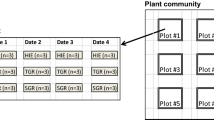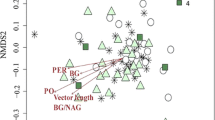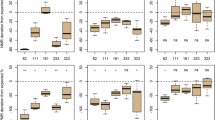Abstract
Approximately 90% of all annual net primary productivity in temperate deciduous forests ends up entering the detritus food web as leaf litter. Due to chemical and physical differences from native litter, inputs from invasive species may impact the litter-dwelling community and ecosystem processes. We compared leaf-litter nutritional quality and decomposition rates from two invasive shrubs, Lonicera maackii and Rhamnus davurica, and the invasive tree Ailanthus altissima to litter from native oak-hickory forest in the Shenandoah Valley of Virginia, USA. We sampled litter from both invaded and uninvaded habitats and conducted litter colonization experiments to test for effects on microflora and the litter-dwelling arthropod communities. Litter from all three invasive species decomposed more rapidly than native litter, with native habitats averaging two to nearly five times as much litter by June. Invasive litter had higher nitrogen concentration and lower C:N ratios than native litter. Invasive litter supported greater growth of bacteria and fungi. Higher numbers of arthropods colonized invasive litter than native litter, but litter arthropod numbers on the forest floor of invaded habitats dropped in the early summer as litter decomposed. Litter had no effect on arthropod richness. Over short time scales, our results indicate that these invasive species represent beneficial, novel resources for the litter-dwelling community. However, the short-lived nature of this resource resulted in a crash in the abundance of the litter-dwelling organisms once the litter decomposed. As a whole, native habitat seems to support a larger, more stable litter-dwelling community over the course of a growing season.




Similar content being viewed by others
References
Aerts R, Ewald M, Nicolas M, Piat J, Skowronek S, Lenoir J, Hattab T, Garzón-López CX, Feilhauer H, Schmidtlein S, Rocchini D, Decocq G, Somers B, Van De Kerchove R, Denef K, Honnay O (2017) Invasion by the alien tree Prunus serotina alters ecosystem funtions in a temperate deciduous forest. Front Plant Sci 8:179. https://doi.org/10.3389/fpls.2017.00179
Antvogel H, Bonn A (2001) Environmental parameters and microspatial distribution of insects: a case study of carabids in an alluvial forest. Ecography 24(4):470–482. https://doi.org/10.1111/j.1600-0587.2001.tb00482.x
Arthur MA, Bray SR, Kuchle CR, McEwan RW (2012) The influence of the invasive shrub, Lonicera maackii, on leaf decomposition and microbial community dynamics. Plant Ecol 213(10):1571–1582. https://doi.org/10.1007/s11258-012-0112-7
Bassett I, Paynter Q, Beggs JR (2011) Invasive Alternanthera philoxeroides (alligator weed) associated with increased fungivore dominance in Coleoptera on decomposing leaf litter. Biol Invasions 13:1377–1385. https://doi.org/10.1007/s1050-01-9896-3
Belnap J, Phillips SL, Sherrod SK, Moldenke A (2005) Soil biota can change after exotic plant invasion: does this affect ecosystem processes? Ecology 86(11):3007–3017. https://doi.org/10.1890/05-0333
Bottollier-Curtet M, Charcosset J-Y, Planty-Tabacchi A-M, Tabbacchi E (2015) Chemical composition rather than plant geographic origin drives the breakdown of riparian plant litter with changes in associated invertebrate density. Plant Soil 390(1–2):265–278. https://doi.org/10.1007/s11104-015-2394-8
Braun EL (1950) Deciduous forests of eastern North America. The Blakiston Company, Philadelphia
Bray SR, Hoyt AM, Yang Z, Arthur MA (2017) Non-native liana, Euonymus fortuna, associated with increased soil nutrients, unique bacterial communities, and faster decomposition rate. Plant Ecol 218(3):329–343. https://doi.org/10.1007/s11258-016-0689-3
Bultman TL, Uetz GW (1984) Effect of structure and nutritional quality of litter on abundances of litter-dwelling arthropods. Am Midl Nat 111(1):165–172
Castro A, Wise DH (2010) Influence of fallen coarse woody debris on the diversity and community structure of forest-floor spiders (Arachnida: Araneae). For Ecol Manag 260(12):2088–2101. https://doi.org/10.1016/j.foreco.2010.08.051
Castro-Díez P, Godoy O, Alonso A, Gallardo A, Saldaña A (2014) What explains variation in the impacts of exotic plant invasions on the nitrogen cycle? A meta-analysis. Ecol Lett 17(1):1–12. https://doi.org/10.1111/ele.12197
Cebrian J (1999) Patterns in the fate of production in plant communities. Am Nat 154(4):449–468. https://doi.org/10.1086/303244
Chen B, Wise SH (1999) Bottom-up limitation of predaceous arthropods in a detritus-based terrestrial food web. Ecology 80(3):761–772. https://doi.org/10.2307/177015
Christopher CC, Cameron GN (2012) Effects of invasive Amur Honeysuckle (Lonicera maackii) and white-tailed deer (Odocoileus virginianus) on litter-dwelling arthropod communities. Am Midl Nat 167(2):256–272. https://doi.org/10.1674/0003-0031-167.2.256
Edmonds WJ, Stiegler J (1982) Soil survey of Clarke County. USDA, Washington
Elgersma KJ, Yu S, Vor T, Ehrenfeld JG (2012) Microbial-mediated feedbacks of leaf litter on invasive plant growth and interspecific competition. Plant Soil 356(1–2):341–355. https://doi.org/10.1007/s11104-011-1117-z
Gessner MO, Swan CM, Dang CK, McKie BG, Bardgett RD, Wall DH, Hättenschwiler S (2010) Diversity meets decomposition. Trends Ecol Evol 25(6):372–380. https://doi.org/10.1016/j/tree/2010.01.010
Gutiérrez-López M, Ranera E, Novo M, Fernández R, Trigo D (2014) Does the invasion of the exotic tree Ailanthus altissima affect the soil arthropod community? The case of a riparian forest of the Henares River (Madrid). Eur J Soil Biol 62:39–48. https://doi.org/10.1016/j.ejsobi.2014.02.010
Handa IT, Aerts R, Berendse F, Berg MP, Bruder A, Butenschoen O, Chauvet E, Gessner MO, Jabiol J, Makkonen M, McKie BG, Malmqvist B, Peeters ETHM, Scheu S, Schmid B, van Ruijven J, Vos VCA, Hättenschwiler S (2014) Consequences of biodiversity loss for litter decomposition across biomes. Nature 509(7499):218–221. https://doi.org/10.1038/nature13247
Heneghan L, Clay C, Brundage C (2002) Rapid decomposition of buckthorn litter may change soil nutrient levels. Ecol Rest 20(2):108–111. https://doi.org/10.3368/er.20.2.108
Hobbie JE, Daley RJ, Jasper S (1977) Use of nuclepore filters for counting bacteria by fluorescence microscopy. Appl Environ Microbiol 33(5):1225–1228
Horváthová T, Babik W, Bauchinger U (2015) Biofilm feeding: Microbial colonization of food promotes the growth of a detritivorous arthropod. ZooKeys 577:25–41. https://doi.org/10.3897/zookeys.577.6149
Jo I, Fridley JD, Frank DA (2017) Invasive plants accelerate nitrogen cycling: evidence from experimental woody monocultures. J Ecol 105(4):1105–1110. https://doi.org/10.1111/1365-2745.12732
Jones PCT, Mollison JE (1948) A technique for the quantitative estimation of soil micro-organisms. Microbiology 2(1):54–69. https://doi.org/10.1099/00221287-2-1-54
Krambeck C, Krambeck H, Overbeck J (1981) Microcomputer-assisted biomass determination of plankton bacteria on scanning electron micrographs. Appl Environ Microbiol 42(1):142–149
Langelotto GA, Denno RF (2004) Responses of invertebrate natural enemies to complex-structured habitats: a meta-analytical synthesis. Oecologia 139(1):1–10. https://doi.org/10.1007/s00442-004-1497-3
Lanta V, Hyvönen T, Norrdahl K (2015) Leaf litter decomposition of nonnative shrub species in nonnative and native shrub environments: a field experiment with three Rosaceae shrubs. Invasive Plant Sci Manag 8(1):81–89. https://doi.org/10.1614/IPSM-D-14-00011.1
Lee MR, Bernhardt ES, van Bodegom PM, Cornelissen JHC, Kattge J, Laughlin DC, Niinemets U, Peñuelas J, Reich PB, Yguel V, Wright JP (2017) Invasive species’ leaf traits and dissimilarity from natives shape their impact on nitrogen cycling: a meta-analysis. New Phytol 213:128–139. https://doi.org/10.1111/nph.14115
Leishman MR, Haslehurst T, Ares A, Baruch Z (2007) Leaf trait relationships of native and invasive plants: community- and global-scale comparisons. New Phytol 176:635–643. https://doi.org/10.1111/j.1469-8137.2007.02189.x
Leishman MR, Thomson VP, Cooke J (2010) Native and exotic invasive plants have fundamentally similar carbon capture strategies. J Ecol 98:28–42. https://doi.org/10.1111/j.1365-2745.2009.01608.x
Lewis SE, Freund JG, Beaver M (2017) Consumption of native green ash and nonnative common buckthorn leaves by the amphipod Gammarus pseudolimnaeus. Am Midl Nat 177(1):100–111. https://doi.org/10.1674/0003-0031-177.1.100
Liao C, Peng R, Luo Y, Zhou X, Wu X, Fang C, Chen J, Li B (2008) Altered ecosystem carbon and nitrogen cycles by plant invasion: a meta-analysis. New Phytol 177:706–714. https://doi.org/10.1111/j.1469-8137.2007.02290.x
Littell RC, Milliken GA, Stroup WW, Wolfinger RD, Schabenberger O (2006) SAS for mixed models, 2nd edn. SAS Institute Inc., Cary
Liu G, Wang L, Jiang L, Pan X, Huang Z, Dong M, Cornelissen JHC (2018) Specific leaf area predicts dryland litter decomposition via two mechanisms. J Ecol 106:218–229. https://doi.org/10.1111/1365-2745.12868
López-Rojo N, Martinez A, Perez J, Basagueren A, Pozo J, Boyero L (2018) Leaf traits drive diversity effects on litter decomposition and FPOM production in streams. PLoS ONE 13(5):e0198243. https://doi.org/10.1371/journal.pone.0198243
Morice S, Pincebourde S, Darboux F, Kaiser W, Casas J (2013) Predator-prey pursuit-evasion games in structurally complex environments. Integr Comp Biol 53(5):767–779. https://doi.org/10.1093/icb/ict061
Motard E, Dusz S, Geslin B, Akpa-Vinceslas M, Hignard C, Babiar O, Clair-Maczulajtys D, Michel-Salzat A (2015) How invasion by Ailanthus altissima transforms soil and litter communities in a temperate forest ecosystem. Biol Invasions 17(6):1817–1832. https://doi.org/10.1007/s10530-014-0838-3
Negrete-Yankelevich S, Fragoso C, Newton AC, Russell G, Heal OW (2008) Species-specific characteristics of trees can determine the litter macroinvertebrate community and decomposition process below their canopies. Plant Soil 307(1–2):83–97. https://doi.org/10.1007/s11104-008-9585-5
Nguyen KQ, Cuneo P, Cunningham SA, Krix DW, Leigh A, Murray BR (2016) Ecological effects of increasing time since invasion by the exotic African olive (Olea europea ssp. cuspidata) on leaf litter invertebrate assemblages. Biol Invasions 18(6):1689–1699. https://doi.org/10.1007/s10530-016-1111-8
Poulette MM, Arthur MA (2012) The impact of the invasive shrub Lonicera maackii on the decomposition dynamics of a native plant community. Ecol Appl 22(2):412–424. https://doi.org/10.1890/11-1105.1
Rodrigues RR, Pineda RP, Barney JN, Nilsen ET, Barrett JE, Williams MA (2015) Plant invasions associated with change in root-zone microbial community structure and diversity. PLoS ONE 10(10):e0141424. https://doi.org/10.1371/journal.pone.0141424
Rusterholz H-P, Salamon J-A, Ruckli R, Baur B (2014) Effects of the annual invasive plant Impatiens glandulifera on the Collembola and Acari communities in a deciduous forest. Pedobiologia 57:285–291. https://doi.org/10.1016/j.pedobi.2014.07.001
Sayer EJ, Sutcliffe LME, Ross RIC, Tanner EVJ (2010) Arthropod abundance and diversity in a lowland tropical forest floor in Panama: the role of habitat space vs. nutrient concentrations. Biotropica 42(2):194–200. https://doi.org/10.1111/j.1744-7429.2009.00576.x
Schuster MJ, Dukes JS (2014) Non-additive effects of invasive tree litter shift seasonal N release: a potential invasion feedback. Oikos 123(9):1101–1111. https://doi.org/10.1111/oik.01078
Standish RJ, Williams PA, Robertson AW, Scott NA, Hedderley DI (2004) Invasion by a perennial herb increases decomposition rate and alters nutrient availability in warm temperate lowland forest remnants. Biol Invasions 6(1):71–81. https://doi.org/10.1023/B:BINV.0000010127.06695.f4
Stokdyk JP, Herrman KS (2014) Short-term impacts of Frangula alnus litter on forest soil properties. Water Air Soil Pollut 225:2000. https://doi.org/10.1007/s11270-014-2000-3
Stokdyk JP, Herrman KS (2016) Effects of Frangula alnus on soil microbial communities and biogeochemical processes in Wisconsin forests. Plant Soil 409(1–2):65–75. https://doi.org/10.1007/s11104-016-2916-z
Swan CM, Healey B, Richardson DC (2008) The role of native riparian tree species in decomposition of invasive tree of heaven (Ailanthus altissima) leaf litterin an urban stream. Ecoscience 15(1):27–35. https://doi.org/10.2980/1195-6860(2008)15[27:TRONRT]2.0CO;2
Trammell TLE, Ralston HA, Scroggins SA, Carreiro MM (2012) Foliar production and decomposition rates in urban forests invaded by the exotic invasive shrub Lonicera maackii. Biol Invasions 14(3):529–545. https://doi.org/10.1007/s10530-011-0093-9
Tuttle NC, Beard KH, Pitt WC (2009) Invasive litter, and an invasive insectivore, determines invertebrate communities in Hawaiian forests. Biol Invasions 11(4):845–855. https://doi.org/10.1007/s.10530-008-9298-y
Uetz GW (1979) The influence of variation in litter habitats on spider communities. Oecologia 40:29–42. https://doi.org/10.1007/BF00388808
van Kleunen M, Weber E, Fischer M (2010) A meta-analysis of trait differences between invasive and non-invasive plant species. Ecol Lett 13:235–245. https://doi.org/10.1111/j.1461-0248.2009.01418
Acknowledgements
Four anonymous reviews provided helpful comments and criticisms of an earlier version of this manuscript. Kara Woodworth assisted with preparing the litter mixtures, and placing them in and collecting them from the field. Tyler Lystash and Michelle Faggert assisted with sorting and identifying the collected arthropods. Dr. Linda Blum provided the necessary equipment and assistance for processing and analyzing the microbial collections. Katherine Fu processed the digital images for analysis of the bacterial and fungal biomass. Paolo D’Odorico, Howie Epstein, Laura Galloway, Kyle Haynes, Michael Pace, T’ai Roulston, and the Blandy’s plant–insect interaction group provided guidance and feedback on this project and manuscript. Blandy Experimental Farm provided the financial support for this project. JW was supported by a grant from the National Science Foundation (DBI-1156796).
Author information
Authors and Affiliations
Contributions
GRW and DEC designed the studies and analyses. GRW and JNW collected and processed samples. GRW wrote the first draft of the manuscript, and all authors contributed to the final version.
Corresponding author
Additional information
Communicated by Stefan Scheu.
Electronic supplementary material
Below is the link to the electronic supplementary material.
Rights and permissions
About this article
Cite this article
Woodworth, G.R., Ward, J.N. & Carr, D.E. Exotic tree and shrub invasions alter leaf-litter microflora and arthropod communities. Oecologia 193, 177–187 (2020). https://doi.org/10.1007/s00442-020-04657-1
Received:
Accepted:
Published:
Issue Date:
DOI: https://doi.org/10.1007/s00442-020-04657-1




